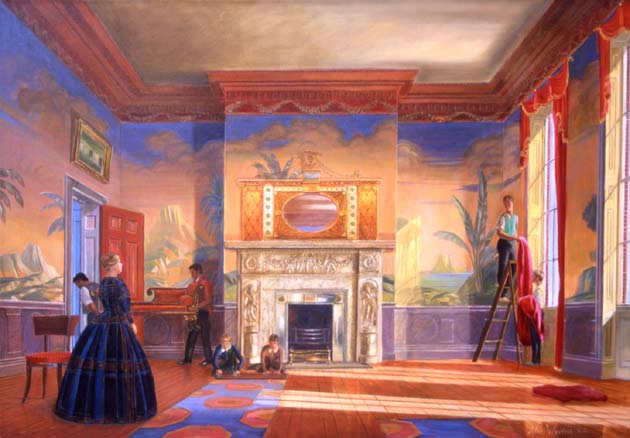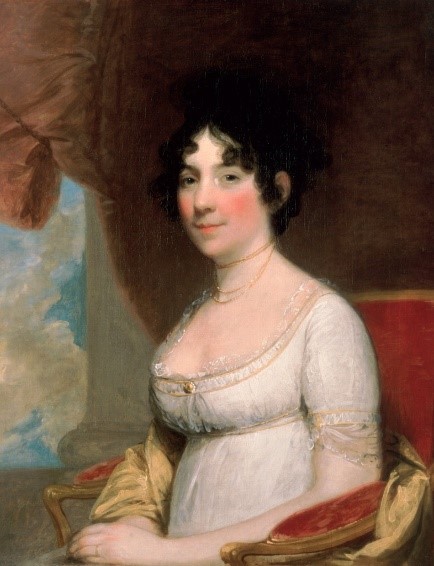Written by AF Staff, Research by Kayla Laws
This Women’s History Month, The Octagon celebrates two dynamic women who have made a mark on this historic home.
“Ann Ogle Tayloe 1804,” By Gilbert Stuart, image from The Octagon archives
Ann Ogle Tayloe was born in 1772 to Maryland Governor Benjamin Ogle and his wife, Henrietta. Ann married wealthy plantation owner John Tayloe III of Virginia in 1792, and eventually gave birth to 15 children, a remarkable 13 of whom lived to adulthood. A consummate and politically-savvy hostess, Ann was renowned for her lavish entertaining at the couple’s Washington, D.C., residence, The Octagon.
Following Ann’s death in 1855, her children decided to sell The Octagon. Artist Peter Waddell captured the scene of the Tayloe family packing up Ann’s opulent drawing room in his painting “Closing up Grandmother’s House,” part of The Octagon’s permanent collection.
“Closing up Grandmother’s House,” painting by Peter Waddell
First Lady Dolly Madison, born in 1768, was a widowed mother with two young children when she was introduced to James Madison, then a Representative from Virginia, in 1794. Just five months later, the couple were married.
“Dolley Madison 1804” By Artist Gilbert Stuart, From the White House Collection/White House Historical Association
In 1809, Madison was elected President of the United States, and moved with Dolley into the White House. Working with architect Benjamin Latrobe, Dolley contributed heavily to the building’s design, helping to select furniture and artwork that would decorate the White House’s entertaining spaces. Like Ann Ogle Tayloe, Dolley Madison was a well-regarded society hostess, and as First Lady she imbued the Washington, D.C., political sphere with gracious sophistication, hosting dinners and salons that attracted the city’s elites.
The War of 1812 upended the Madison’s tenure at the White House. British forces raided Washington in 1814, burning important buildings including the White House. Dolley was forced to leave, but according to Jesse J. Holland’s The Invisibles: The Untold Story of African American Slaves in the White House, the tale of Dolley Madison saving the portrait of George Washington from being destroyed in the flames is merely a myth—in actuality, it was Paul Jennings who rescued the portrait.
Octagon House postcard, 1910s
After leaving the White House, President Madison and Dolley moved to The Octagon, the nearby home of his acquaintances John and Ann Tayloe, for six months. Although archival materials indicate that Dolley Madison was displeased with The Octagon—citing shortcomings including its size (too small), its environment (too damp), and its decoration (lacking a piano, notably)—she swiftly resumed carrying out her relentless entertaining calendar at her new residence.
She wanted to keep the “morale of the city high,” according to Octagon archives. In The Octagon’s drawing room, she continued her tradition of the “Wednesday Night Squeeze,” so named because the large number of people in in attendance were forced to “squeeze in.”
The drawing room, image from The Octagon archive
According to Catherine Allgor’s A Perfect Union, “the most conspicuous object in the room, the observed of all observers was Mrs. Madison herself.”
The Madisons departed The Octagon in March 1815, but Dolley Madison’s legacy lives on. According to some, that’s not all she left behind. Some visitors to The Octagon, including another First Lady, Jaqueline Kennedy, have reportedly smelled a distinctive lilac perfume in The Octagon’s drawing room, said to be the favored scent of Dolley Madison. A ghostly presence, or total nonsense? You can decide for yourself during The Octagon’s annual Poltergeists and Pints tour each October.
References
“Ann Ogle Tayloe and Children.” National Portrait Gallery, npg.si.edu/object/npg_52.15.7.
“Dolley Madison.” WHHA (En-US), www.whitehousehistory.org/bios/dolley-madison.
“The Octagon.” Peter Waddell, 1 Jan. 2019, peterwaddell.com/commissions/the-octagon/.
Documents and images from The Octagon archives used with permission of the Architects Foundation.





